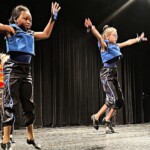What is pointe?
Pointe is the epitome of ballet—a technical skill that takes ballerinas from intermediate dancers to advanced.
First of all one needs to know that when referring to “pointe” in dance, the foot—particularly, arching the foot and pointing the toes. This creates a continuous and elegant line along the whole leg, and also allows for agility and lightness during routines. To dance “en pointe” (on point) is to stand on the very “tippy-toes” of the foot and do maneuvers from there. Initially, this style of dancing was to allow the ballerinas to hover, to float and flit across the stage as if flying, particularly because many there are many roles for fairy folk and ethereal creatures in classical ballet story telling. To do this, a special shoe was developed with a flat toe box and strong structural arch support, to take the weight of the dancer, and to provide as much comfort as possible—though comfort is relative when putting 100+ lbs of dancer on a very small amount of surface area!
Generally, being granted access to pointe shoes from a dance instructor is a graduation into the very elite and technical realms of ballet. This is where a young dancer will decide if they are serious enough to keep dancing through their teens as intermediate-advance.
On point you can take maneuvers to another level. And, yes—note that a young dancer will need a referral from a teacher to receive a fitting for their first pair of pointe shoes.
What age is appropriate to consider pre-pointe class?
Because of the strength needed to dance on pointe safely, dancers must have at least three to four years of intensive dancing—this usually means they’ve been taking ballet even before that, and puts ballerinas in the 12 year-old age bracket. Depending on strength, they might be younger, and they might be older.
Why do you need a special class for it?
Pointe shoes require incredible strength in parts of the body that non-dancers rarely exercise: the ankles and feet! Special exercises are used to pinpoint the appropriate muscles, so that dancers can ascend onto their toes safely, and descend with control. The majority of the time spent in pre-pointe class is as the barre.
The dance instructors at the Omaha School of Music and Dance use these classes to evaluate if students are improving in the technique and strength required for safely dancing on pointe.
What sorts of exercises are exclusive for pre-pointe class?
Barre in the beginning….
- 10-15 mins at the barre in their point shoes.
- Looking for strength to balance one leg on demi-pointe very well.
- Flexibility to point their toes
Calf muscles and ankles muscles. Kids have cartilage that is still soft, and around 12 is when it gets set—flexibility exercises can help. There are more difficult exercises, because it’s intermediate, with the goal for advancement.
- Tips and tricks are covered
- Our instructors like to go with their students to buy pointe shoes
- Dancers looking to go onto point need to be taking classes at least 2 time a week
- Taking pre-point to get ONTO POINT
- The epitome of ballet
- Pointe is an extension of ballet—it’s the next level
Call today – (402) 515-9639 or Register online.



